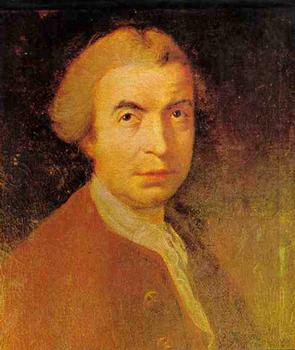Croatian mathematician
Biographical Information
| Name: | Ruggero Boscovich |
|---|---|
| Full name: | Ruggero Giuseppe Boscovich |
| Born on | 18 May 1711 in Dubrovnik, Dubrovnik-Neretva, Croatia, Europe |
| Deceased on | 13 February 1787 in Milan, Milano, Lombardy, Italy, Europe |
Short Biography of Ruggero Boscovich
The son of the merchant Nikola Boscovich and Paula Bettera, the daughter of a merchant from Bergamo, Boscovich attended the Jesuit College of his home town and afterwards Sant'Andrea in Rome. He continued his studies in theology at the Collegium Romanum and from 1735 onwards adopted Newton's Opticks and Principia, and by 1740 he had been promoted to professor of mathematics at the Collegium Romanum. Two years later he worked with Tommaso Le Seur and Francesco Jacquier to compile a report on the damage to the dome of St.Peter's, which in the literature of civil engineering is today still regarded as the first theory of structures in the world. Based on an analysis of damage and cracks, the tre mattematici calculated the horizontal thrust with the help of the work theorem, which formed the quantitative basis for the refurbishment of the dome construction with the help of iron ties in the form of a ring beam. Boscovich was appointed by the Vatican to provide further reports, e. g. drainage of the Pontifical marshes, river training works for the Tiber, extensions to the harbours at Rimini and Savona. In 1758 Boscovich published his Theoria philosophiae naturalis, an atomic theory according to which the world consists not of continuous matter, but instead of countless “point-like structures”; the ultimate elements of matter are indivisible points – “atoms” – which are centres of force and this force varies in proportion to distance. From his revolutionary discovery that “every material point a point in space and a moment in time”, he surmised some 150 years before Ernst Mach, Henri Poincaré and Albert Einstein the relativity principle of modern physics from the criticism of the understanding of inertia in traditional mechanics. In the 19th century his atomic theory formed the basis of the rari-constant theory (discontinuum hypothesis, molecular hypothesis) of elastic theory, which, however, could not displace the multi-constant theory (continuum hypothesis), but later found favour again in the modern atomic theory of Max Born [Foce, 1993; 1995]. Criticism of Boscovich's Theoria philosophiae naturalis from the viewpoint of Aristotelian natural philosophy was not long in coming. The inflammatory discussion was fuelled by the fact that Boscovich's ideas for reforming studies were aimed directly at the scholastic teaching traditions of the universities influenced by the Catholic Church, which hindered the evolution of the exact sciences. In 1759 Boscovich left Rome via Paris. He was elected a member of the Royal Society in London in 1761. Boscovich was now a traveller with a torch of enlightenment across Europe like no other. He became an outstanding organiser and promoter of scientific activities on a European scale. For instance, he inspired a series of meridian curve measurements (measurement of geographical longitude) which proved that the Earth did not have the “form of a distended melon” , but instead confirmed Newton's hypo-thesis of an ellipsoid flattened at the poles. Newton's theory of gravity had finally found its way into geodesy. Boscovich's work was widely acclaimed in the 20th century. At EXPO 2000 in Hannover, Germany, a replica of the Boscovich monument in Zagreb formed the centrepiece of the Croatian exhibition pavilion – immersed in a multimedia, seemingly transcendental simulation of the universe. Even today, his prophetic worldly wisdom thus works like a universalpromise of the coming spirituality of the human race.
Main contributions to structural analysis:
- Parere di tre mattematici sopra i danni, che si sono trovati nella cupola di S. Pietro sul fine dell'Anno MDCCXLII, dato per ordine di Nostro Signore Papa Bendetto XIV [1743];
- De motu corporis attracti in centrum immobile viribus decrescentibus in ratione distantiarum reciproca duplicata in spatiis non resistentibus. Dissertatio [1743];
- Elementorum Universae Matheseos [1754];
- De Lege Virium in Natura existentium, Dissertatio [1755];
- Philosophiae naturalis theoria redacata ad unicam legem virium in natura existentium [1758];
- Scrittura sulli danni osservati, nell'edificio delle Biblioteca Cesarea di Vienna, e loro riparazione, composta in occasione de' Sovrani commandi di Sua Maestà l'Imperatrice Regina Maria Teresa, e umiliata a suoi piedi pel felicissimo anniversario (13 Mai 1763) della sua nascita [1763];
- Sentimento sulla solidità della nuova Guglia del Duomo di Milano o si consideri in se stessa, o rispetto al rimanente del vasto Tempio, esposto a richiesta del Nobilissimo e Vigilantissimo Capitolo che sopraintende alla sua gran fabbrica [1764]
Source: Kurrer, Karl-Eugen The History of the Theory of Structures, Wilhelm Ernst & Sohn Verlag für Architektur und technische Wissenschaften GmbH, Berlin (Deutschland), ISBN 3-433-01838-3, 2008; p. 718/719
Relevant Publications
- (2008): The History of the Theory of Structures. From Arch Analysis to Computational Mechanics. 1st edition, Wilhelm Ernst & Sohn Verlag für Architektur und technische Wissenschaften GmbH, Berlin (Germany), ISBN 978-3-433-01838-5, pp. 718-719.
- (2018): The History of the Theory of Structures. Searching for Equilibrium. 2nd edition, Wilhelm Ernst & Sohn Verlag für technische Wissenschaften, Berlin (Germany), ISBN 978-3-433-03229-9, pp. 974-975.
- About this
data sheet - Person-ID
1009699 - Published on:
03/05/2013 - Last updated on:
22/07/2014




